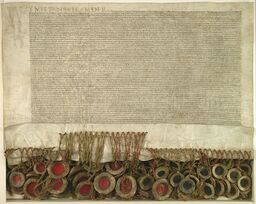 The Act of Union of Poland and Lithuania created the first major Republic in Europe
The Act of Union of Poland and Lithuania created the first major Republic in Europe The Commonwealth was ruled by a single elected monarch who carried out the duties of King of Poland and Grand Duke of Lithuania, and governed with a common Senate and parliament (the Sejm). The Union is seen by some as an evolutionary stage in the Polish–Lithuanian alliance and personal union, necessitated also by Lithuania's dangerous position in wars with Russia.
The Sejm met in January 1569, near the Polish town of Lublin, but did not reach an agreement. One of the points of contention was the right of Poles to settle and own land in the Grand Duchy. After most of the Lithuanian delegation under the leadership of Vilnius Voivodeship's Mikołaj "Rudy" Radziwiłł left Lublin on 1 March, the king responded by annexing Podlachie, Volhynian, Bracław, and the Kiev Voivodeships to the Crown (on 6 June), with wide approval from the local gentry. Those historic lands of Rus' are over half of modern Ukraine and were then a substantial portion of the Grand Duchy of Lithuania's territory. The Rus' nobles there were eager to capitalise on the economic and political opportunities offered by the Polish sphere, and by and large, they wanted their lands to become a part of the Polish Crown.
The Lithuanians were forced to return to the Sejm under the leadership of Jan Hieronimowicz Chodkiewicz (father of Jan Karol Chodkiewicz) and to continue negotiations, using slightly different tactics from those of Radziwiłł. Though the Polish szlachta wanted full incorporation of the Grand Duchy of Lithuania into the Crown, the Lithuanians continued to oppose that and agreed only to a federal state. On 28 June 1569, the last objections were overcome, the Sejm proceeded to adopt the act on July 1, and on 4 July 4, the act was accordingly signed by the king at Lublin Castle. The Polish–Lithuanian Commonwealth reached the apex of its power during the next half century before entering a period of decline due in part to the machinations of the Russian and German states bordering the Commonwealth which viewed its democratic form of government with suspicion.
In 1791, the Commonwealth official returned to the status of a hereditary monarchy following the First and Second Partitions of Poland in 1772 and 1790 and was thereafter known as the Commonwealth of Poland. The Partitions of Poland were the result of the the decline in the Commonwealth's strength and the corresponding rise in power of the Russian Empire and the German states, principally Prussia. A third partition of Poland in 1795 effectively ended the independence of Poland for 123 years.
 RSS Feed
RSS Feed